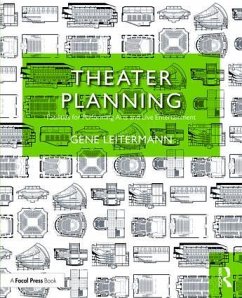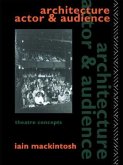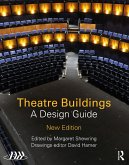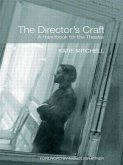- Broschiertes Buch
- Merkliste
- Auf die Merkliste
- Bewerten Bewerten
- Teilen
- Produkt teilen
- Produkterinnerung
- Produkterinnerung
This book introduces theater planning to students and practitioners of each field, and provides a detailed guide to the process and the technical requirements particular to theater buildings. Part I is a guide to the concepts and practices of architecture and construction, as applied to performing arts buildings. Part II is a guide to the design of performing arts buildings, with detailed descriptions of the unique requirements of these buildings. Each concept is illustrated with line drawings and examples from the author's extensive professional practice.
Andere Kunden interessierten sich auch für
![Architecture, Actor and Audience Architecture, Actor and Audience]() Iain MackintoshArchitecture, Actor and Audience62,99 €
Iain MackintoshArchitecture, Actor and Audience62,99 €![Theatre Buildings Theatre Buildings]() Theatre Buildings78,99 €
Theatre Buildings78,99 €![University Trends University Trends]() Jonathan Coulson (Turnberry Consulting Ltd UK Director)University Trends145,99 €
Jonathan Coulson (Turnberry Consulting Ltd UK Director)University Trends145,99 €![Fifty Key Theatre Directors Fifty Key Theatre Directors]() Maria Shevtsova (ed.)Fifty Key Theatre Directors50,99 €
Maria Shevtsova (ed.)Fifty Key Theatre Directors50,99 €![Sound and Music for the Theatre Sound and Music for the Theatre]() Deena KayeSound and Music for the Theatre56,99 €
Deena KayeSound and Music for the Theatre56,99 €![Food and Theatre on the World Stage Food and Theatre on the World Stage]() Food and Theatre on the World Stage62,99 €
Food and Theatre on the World Stage62,99 €![The Director's Craft The Director's Craft]() Katie Mitchell (UK The Royal National Theatre)The Director's Craft39,99 €
Katie Mitchell (UK The Royal National Theatre)The Director's Craft39,99 €-
-
-
This book introduces theater planning to students and practitioners of each field, and provides a detailed guide to the process and the technical requirements particular to theater buildings. Part I is a guide to the concepts and practices of architecture and construction, as applied to performing arts buildings. Part II is a guide to the design of performing arts buildings, with detailed descriptions of the unique requirements of these buildings. Each concept is illustrated with line drawings and examples from the author's extensive professional practice.
Hinweis: Dieser Artikel kann nur an eine deutsche Lieferadresse ausgeliefert werden.
Hinweis: Dieser Artikel kann nur an eine deutsche Lieferadresse ausgeliefert werden.
Produktdetails
- Produktdetails
- Verlag: Taylor & Francis Ltd
- Seitenzahl: 332
- Erscheinungstermin: 21. Februar 2017
- Englisch
- Abmessung: 233mm x 189mm x 22mm
- Gewicht: 724g
- ISBN-13: 9781138888982
- ISBN-10: 1138888982
- Artikelnr.: 46504199
- Herstellerkennzeichnung
- Libri GmbH
- Europaallee 1
- 36244 Bad Hersfeld
- gpsr@libri.de
- Verlag: Taylor & Francis Ltd
- Seitenzahl: 332
- Erscheinungstermin: 21. Februar 2017
- Englisch
- Abmessung: 233mm x 189mm x 22mm
- Gewicht: 724g
- ISBN-13: 9781138888982
- ISBN-10: 1138888982
- Artikelnr.: 46504199
- Herstellerkennzeichnung
- Libri GmbH
- Europaallee 1
- 36244 Bad Hersfeld
- gpsr@libri.de
Gene Leitermann is co-founder of Nextstage Design, a theater design consulting firm with a national practice. He has been the lead theater designer on more than 100 buildings. A faculty member at Yale School of Drama since 1998, Gene has also lectured internationally. He has provided public testimony, code change proposals, and written commentary to the National Fire Protection Association, International Code Council, and United States Access Board. Gene is a member of the American Society of Theatre Consultants (ASTC).
Table of Contents
Part I Context and process
1 Theater buildings
2 Project roles
3 Project phases
4 Project delivery methods
5 Pre-design process
6 Design process
7 Building regulations
8 Project budgets
Part II Planning
9 Proscenium stages
10 Forestage zone
11 Other stage forms
12 Audience sightlines
13 Audience seating
14 Auditorium design
15 Technical elements
16 Public spaces
17 Back-of-house spaces
List of Figures
Chapter 1
Figure 1.1 Drama theater forms
Figure 1.2 Fichandler Theatre, Arena Stage, Washington, DC
Figure 1.3 Ruth Caplin Theatre, University of Virginia, Charlottesville,
Virginia
Figure 1.4 Studio, Tempe Center for the Arts, Tempe, Arizona
Figure 1.5 Kay Theatre, Clarice Smith Performing Arts Center, College Park,
Maryland
Figure 1.6 Studzinski Recital Hall, Bowdoin College, Brunswick, Maine
Figure 1.7 Laura Turner Concert Hall, Schermerhorn Symphony Center,
Nashville, Tennessee
Figure 1.8 Helzberg Concert Hall, Kauffman Center for the Performing Arts,
Kansas City, Missouri
Figure 1.9 Oslo Opera House, Oslo, Norway
Figure 1.10 Dance Theatre, Clarice Smith Performing Arts Center, College
Park, Maryland
Figure 1.11 Overture Hall, Overture Center, Madison, Wisconsin
Figure 1.12 Dolby Theatre (formerly Kodak Theatre), Hollywood, California
Chapter 2
Figure 2.1 Primary contractual relationships
Figure 2.2 Simple owner structure
Figure 2.3 Owner with program manager
Figure 2.4 Core design team working for the architect
Figure 2.5 Core design team working for owner
Chapter 3
Figure 3.1 Comparison of project phases
Figure 3.2 Opportunity for savings versus design fees spent
Chapter 4
Figure 4.1 Design-bid-build
Figure 4.2 Design-bid-build versus fast track
Figure 4.3 Multiple prime contracts
Figure 4.4 Design-build
Figure 4.5 Agency construction manager
Figure 4.6 Construction manager at risk
Figure 4.7 Integrated project delivery
Chapter 5
Figure 5.1 Needs assessment example: Overture Center, Madison, Wisconsin
Figure 5.2 Area definitions for performing arts buildings
Chapter 6
Figure 6.1 Options for 400-seat theater form
Figure 6.2 400-seat theater footprint and volume study in Broadway form
Figure 6.3 400-seat theater conceptual diagram
Figure 6.4 400-seat theater plan and section drawings
Figure 6.5 400-seat theater geometry study
Figure 6.6 400-seat theater material and finish study
Figure 6.7 Completed 400-seat theater
Figure 6.8 Site plan showing context
Figure 6.9 Conceptual site plan
Figure 6.10 Functional site diagram
Figure 6.11 Site plan
Figure 6.12 Block model
Figure 6.13 Site rendering
Figure 6.14 Site rendering
Figure 6.15 Site model
Figure 6.16 Site rendering
Figure 6.17 Completed building
Figure 6.18 Planning diagrams
Figure 6.19 Planning diagrams
Figure 6.20 Floor plans
Figure 6.21 Plan and section diagrams
Figure 6.22 Lobby rendering-schematic design
Figure 6.23 Lobby rendering-design development
Figure 6.24 Completed lobby
Figure 6.25 Crossover material and finish studies
Figure 6.26 Completed crossover
Chapter 9
Figure 9.1 Golden rectangle
Figure 9.2 Stage plan and transverse section
Figure 9.3 Acting area (after Burris-Meyer and Cole)
Figure 9.4 Scenery area (after Burris-Meyer and Cole)
Figure 9.5 Circulation and work area (after Burris-Meyer and Cole)
Figure 9.6 Percentage of audience with full view of backdrop
Figure 9.7 Proscenium widths of Broadway theaters
Figure 9.8 Modern dance footprint
Figure 9.9 Classical dance footprint
Figure 9.10 Opera house stages
Chapter 10
Figure 10.1 Forestage zone
Figure 10.2 Orchestra pit geometry and sightlines
Figure 10.3 Orchestra pit configurations
Chapter 11
Figure 11.1 Thrust stages
Figure 11.2 Open stages
Figure 11.3 Arena stages
Figure 11.4 Recital halls
Figure 11.5 Concert halls
Figure 11.6 Orchestra accommodation in proscenium theaters
Chapter 12
Figure 12.1 Seated spectator
Figure 12.2 Horizontal sightlines
Figure 12.3 Vertical sightlines
Figure 12.4 Constant rise sightlines
Figure 12.5 Isacoustic (isodomal) rise sightlines
Figure 12.6 First and second row vision
Figure 12.7 Three approaches to chair layout
Figure 12.8 Effect of v and h values
Figure 12.9 Venues without balconies
Figure 12.10 Crossaisle sightlines
Figure 12.11 Oblique sightlines
Figure 12.12 Playhouses with balconies
Figure 12.13 Concert halls and opera houses
Figure 12.14 Multipurpose theaters
Chapter 13
Figure 13.1 Fixed auditorium chairs and wheelchairs spaces
Figure 13.2 Fixed auditorium chairs on (a) shallow slope and (b) steep
slope
Figure 13.3 Catchment area example (after NFPA)
Figure 13.4 Catchment area example with crossaisle
Chapter 14
Figure 14.1 Typical seating density in (a) early twentieth century
auditorium and (b) early twenty-first century auditorium
Figure 14.2 Globe Theatre, London
Figure 14.3 Corral de Comedias, Almagro, Spain
Figure 14.4 Symphony Hall, Boston
Figure 14.5 Laura Turner Concert Hall, Schermerhorn Symphony Center,
Nashville, Tennessee
Figure 14.6 Philharmonic Hall, Szczecin, Poland
Figure 14.7 Teatro Argentina, Rome
Figure 14.8 Paris Opéra (Palais Garnier), Paris
Figure 14.9 Teatro Colon, Buenos Aires, Argentina
Figure 14.10 Ford's Theater, Washington, DC
Figure 14.11 Auditorium Theatre, Chicago
Figure 14.12 Lyceum Theatre, New York
Figure 14.13 Detail of a Medieval scaffold stage
Figure 14.14 Theater of Epidaurus, Greece
Figure 14.15 Roman theater at Aspendos, Pamphylia, (modern Turkey)
Figure 14.16 Teatro Farnese, Parma, Italy
Figure 14.17 Fichandler Theatre, Arena Stage, Washington, DC
Figure 14.18 Berliner Philharmonie, Berlin
Figure 14.19 Helzberg Concert Hall, Kauffman Center for the Performing
Arts, Kansas City, Missouri
Figure 14.20 Bayreuth Festspielhaus, Bayreuth, Germany
Figure 14.21 Well's Theatre, Norfolk, Virginia
Figure 14.22 Shubert Theatre, New Haven, Connecticut
Figure 14.23 Malmö Opera (formerly Malmö Stadsteater), Malmö, Sweden
Figure 14.24 Marion Oliver McCaw Hall, Seattle, Washington
Figure 14.25 Five approaches to side wall architecture
Figure 14.26 Overture Hall, Overture Center, Madison, Wisconsin
Figure 14.27 Radio City Music Hall, New York
Chapter 15
Figure 15.1 Controls rooms at rear of main seating level
Figure 15.2 Control room sightlines
Figure 15.3 Sound cockpit lift and wagon arrangement
Figure 15.4 Followspot room sightlines
Figure 15.5 Front-of-house catwalk study
Figure 15.6 Front-of-house lighting provisions
Chapter 16
Figure 16.1 Standard body ellipse
Figure 16.2 Standard body ellipse in 10-square-foot area (typical lobby
benchmark)
Figure 16.3 Lobby density expressed as net square feet per seat
List of Tables
Chapter 1
Table 1.1 Typical theater forms and seat counts by performance type
Chapter 2
Table 2.1 Owner and user example: Overture Center, Madison, Wisconsin
Table 2.2 Design team example: Overture Center, Madison, Wisconsin
Chapter 3
Table 3.1 CSI MasterFormat Divisions
Table 3.2 Contract Document Drawing Volumes: Overture Center, Madison
Wisconsin
Chapter 5
Table 5.1 Example space list
Chapter 7
Table 7.1 Accessibility legislation affecting the design of performance
facilities
Chapter 8
Table 8.1 Typical project cost components
Table 8.2 Simplified project budget
Chapter 9
Table 9.1 Stage dimension ratios
Table 9.2 Broadway theaters
Table 9.3 Regional theaters
Table 9.4 Dance theaters
Table 9.5 Opera houses
Table 9.6 Multipurpose halls
Table 9.7 School halls
Chapter 13
Table 13.1 Required number of wheelchair spaces
Table 13.2 Minimum aisle widths per IBC 2015 in inches
Part I Context and process
1 Theater buildings
2 Project roles
3 Project phases
4 Project delivery methods
5 Pre-design process
6 Design process
7 Building regulations
8 Project budgets
Part II Planning
9 Proscenium stages
10 Forestage zone
11 Other stage forms
12 Audience sightlines
13 Audience seating
14 Auditorium design
15 Technical elements
16 Public spaces
17 Back-of-house spaces
List of Figures
Chapter 1
Figure 1.1 Drama theater forms
Figure 1.2 Fichandler Theatre, Arena Stage, Washington, DC
Figure 1.3 Ruth Caplin Theatre, University of Virginia, Charlottesville,
Virginia
Figure 1.4 Studio, Tempe Center for the Arts, Tempe, Arizona
Figure 1.5 Kay Theatre, Clarice Smith Performing Arts Center, College Park,
Maryland
Figure 1.6 Studzinski Recital Hall, Bowdoin College, Brunswick, Maine
Figure 1.7 Laura Turner Concert Hall, Schermerhorn Symphony Center,
Nashville, Tennessee
Figure 1.8 Helzberg Concert Hall, Kauffman Center for the Performing Arts,
Kansas City, Missouri
Figure 1.9 Oslo Opera House, Oslo, Norway
Figure 1.10 Dance Theatre, Clarice Smith Performing Arts Center, College
Park, Maryland
Figure 1.11 Overture Hall, Overture Center, Madison, Wisconsin
Figure 1.12 Dolby Theatre (formerly Kodak Theatre), Hollywood, California
Chapter 2
Figure 2.1 Primary contractual relationships
Figure 2.2 Simple owner structure
Figure 2.3 Owner with program manager
Figure 2.4 Core design team working for the architect
Figure 2.5 Core design team working for owner
Chapter 3
Figure 3.1 Comparison of project phases
Figure 3.2 Opportunity for savings versus design fees spent
Chapter 4
Figure 4.1 Design-bid-build
Figure 4.2 Design-bid-build versus fast track
Figure 4.3 Multiple prime contracts
Figure 4.4 Design-build
Figure 4.5 Agency construction manager
Figure 4.6 Construction manager at risk
Figure 4.7 Integrated project delivery
Chapter 5
Figure 5.1 Needs assessment example: Overture Center, Madison, Wisconsin
Figure 5.2 Area definitions for performing arts buildings
Chapter 6
Figure 6.1 Options for 400-seat theater form
Figure 6.2 400-seat theater footprint and volume study in Broadway form
Figure 6.3 400-seat theater conceptual diagram
Figure 6.4 400-seat theater plan and section drawings
Figure 6.5 400-seat theater geometry study
Figure 6.6 400-seat theater material and finish study
Figure 6.7 Completed 400-seat theater
Figure 6.8 Site plan showing context
Figure 6.9 Conceptual site plan
Figure 6.10 Functional site diagram
Figure 6.11 Site plan
Figure 6.12 Block model
Figure 6.13 Site rendering
Figure 6.14 Site rendering
Figure 6.15 Site model
Figure 6.16 Site rendering
Figure 6.17 Completed building
Figure 6.18 Planning diagrams
Figure 6.19 Planning diagrams
Figure 6.20 Floor plans
Figure 6.21 Plan and section diagrams
Figure 6.22 Lobby rendering-schematic design
Figure 6.23 Lobby rendering-design development
Figure 6.24 Completed lobby
Figure 6.25 Crossover material and finish studies
Figure 6.26 Completed crossover
Chapter 9
Figure 9.1 Golden rectangle
Figure 9.2 Stage plan and transverse section
Figure 9.3 Acting area (after Burris-Meyer and Cole)
Figure 9.4 Scenery area (after Burris-Meyer and Cole)
Figure 9.5 Circulation and work area (after Burris-Meyer and Cole)
Figure 9.6 Percentage of audience with full view of backdrop
Figure 9.7 Proscenium widths of Broadway theaters
Figure 9.8 Modern dance footprint
Figure 9.9 Classical dance footprint
Figure 9.10 Opera house stages
Chapter 10
Figure 10.1 Forestage zone
Figure 10.2 Orchestra pit geometry and sightlines
Figure 10.3 Orchestra pit configurations
Chapter 11
Figure 11.1 Thrust stages
Figure 11.2 Open stages
Figure 11.3 Arena stages
Figure 11.4 Recital halls
Figure 11.5 Concert halls
Figure 11.6 Orchestra accommodation in proscenium theaters
Chapter 12
Figure 12.1 Seated spectator
Figure 12.2 Horizontal sightlines
Figure 12.3 Vertical sightlines
Figure 12.4 Constant rise sightlines
Figure 12.5 Isacoustic (isodomal) rise sightlines
Figure 12.6 First and second row vision
Figure 12.7 Three approaches to chair layout
Figure 12.8 Effect of v and h values
Figure 12.9 Venues without balconies
Figure 12.10 Crossaisle sightlines
Figure 12.11 Oblique sightlines
Figure 12.12 Playhouses with balconies
Figure 12.13 Concert halls and opera houses
Figure 12.14 Multipurpose theaters
Chapter 13
Figure 13.1 Fixed auditorium chairs and wheelchairs spaces
Figure 13.2 Fixed auditorium chairs on (a) shallow slope and (b) steep
slope
Figure 13.3 Catchment area example (after NFPA)
Figure 13.4 Catchment area example with crossaisle
Chapter 14
Figure 14.1 Typical seating density in (a) early twentieth century
auditorium and (b) early twenty-first century auditorium
Figure 14.2 Globe Theatre, London
Figure 14.3 Corral de Comedias, Almagro, Spain
Figure 14.4 Symphony Hall, Boston
Figure 14.5 Laura Turner Concert Hall, Schermerhorn Symphony Center,
Nashville, Tennessee
Figure 14.6 Philharmonic Hall, Szczecin, Poland
Figure 14.7 Teatro Argentina, Rome
Figure 14.8 Paris Opéra (Palais Garnier), Paris
Figure 14.9 Teatro Colon, Buenos Aires, Argentina
Figure 14.10 Ford's Theater, Washington, DC
Figure 14.11 Auditorium Theatre, Chicago
Figure 14.12 Lyceum Theatre, New York
Figure 14.13 Detail of a Medieval scaffold stage
Figure 14.14 Theater of Epidaurus, Greece
Figure 14.15 Roman theater at Aspendos, Pamphylia, (modern Turkey)
Figure 14.16 Teatro Farnese, Parma, Italy
Figure 14.17 Fichandler Theatre, Arena Stage, Washington, DC
Figure 14.18 Berliner Philharmonie, Berlin
Figure 14.19 Helzberg Concert Hall, Kauffman Center for the Performing
Arts, Kansas City, Missouri
Figure 14.20 Bayreuth Festspielhaus, Bayreuth, Germany
Figure 14.21 Well's Theatre, Norfolk, Virginia
Figure 14.22 Shubert Theatre, New Haven, Connecticut
Figure 14.23 Malmö Opera (formerly Malmö Stadsteater), Malmö, Sweden
Figure 14.24 Marion Oliver McCaw Hall, Seattle, Washington
Figure 14.25 Five approaches to side wall architecture
Figure 14.26 Overture Hall, Overture Center, Madison, Wisconsin
Figure 14.27 Radio City Music Hall, New York
Chapter 15
Figure 15.1 Controls rooms at rear of main seating level
Figure 15.2 Control room sightlines
Figure 15.3 Sound cockpit lift and wagon arrangement
Figure 15.4 Followspot room sightlines
Figure 15.5 Front-of-house catwalk study
Figure 15.6 Front-of-house lighting provisions
Chapter 16
Figure 16.1 Standard body ellipse
Figure 16.2 Standard body ellipse in 10-square-foot area (typical lobby
benchmark)
Figure 16.3 Lobby density expressed as net square feet per seat
List of Tables
Chapter 1
Table 1.1 Typical theater forms and seat counts by performance type
Chapter 2
Table 2.1 Owner and user example: Overture Center, Madison, Wisconsin
Table 2.2 Design team example: Overture Center, Madison, Wisconsin
Chapter 3
Table 3.1 CSI MasterFormat Divisions
Table 3.2 Contract Document Drawing Volumes: Overture Center, Madison
Wisconsin
Chapter 5
Table 5.1 Example space list
Chapter 7
Table 7.1 Accessibility legislation affecting the design of performance
facilities
Chapter 8
Table 8.1 Typical project cost components
Table 8.2 Simplified project budget
Chapter 9
Table 9.1 Stage dimension ratios
Table 9.2 Broadway theaters
Table 9.3 Regional theaters
Table 9.4 Dance theaters
Table 9.5 Opera houses
Table 9.6 Multipurpose halls
Table 9.7 School halls
Chapter 13
Table 13.1 Required number of wheelchair spaces
Table 13.2 Minimum aisle widths per IBC 2015 in inches
Table of Contents
Part I Context and process
1 Theater buildings
2 Project roles
3 Project phases
4 Project delivery methods
5 Pre-design process
6 Design process
7 Building regulations
8 Project budgets
Part II Planning
9 Proscenium stages
10 Forestage zone
11 Other stage forms
12 Audience sightlines
13 Audience seating
14 Auditorium design
15 Technical elements
16 Public spaces
17 Back-of-house spaces
List of Figures
Chapter 1
Figure 1.1 Drama theater forms
Figure 1.2 Fichandler Theatre, Arena Stage, Washington, DC
Figure 1.3 Ruth Caplin Theatre, University of Virginia, Charlottesville,
Virginia
Figure 1.4 Studio, Tempe Center for the Arts, Tempe, Arizona
Figure 1.5 Kay Theatre, Clarice Smith Performing Arts Center, College Park,
Maryland
Figure 1.6 Studzinski Recital Hall, Bowdoin College, Brunswick, Maine
Figure 1.7 Laura Turner Concert Hall, Schermerhorn Symphony Center,
Nashville, Tennessee
Figure 1.8 Helzberg Concert Hall, Kauffman Center for the Performing Arts,
Kansas City, Missouri
Figure 1.9 Oslo Opera House, Oslo, Norway
Figure 1.10 Dance Theatre, Clarice Smith Performing Arts Center, College
Park, Maryland
Figure 1.11 Overture Hall, Overture Center, Madison, Wisconsin
Figure 1.12 Dolby Theatre (formerly Kodak Theatre), Hollywood, California
Chapter 2
Figure 2.1 Primary contractual relationships
Figure 2.2 Simple owner structure
Figure 2.3 Owner with program manager
Figure 2.4 Core design team working for the architect
Figure 2.5 Core design team working for owner
Chapter 3
Figure 3.1 Comparison of project phases
Figure 3.2 Opportunity for savings versus design fees spent
Chapter 4
Figure 4.1 Design-bid-build
Figure 4.2 Design-bid-build versus fast track
Figure 4.3 Multiple prime contracts
Figure 4.4 Design-build
Figure 4.5 Agency construction manager
Figure 4.6 Construction manager at risk
Figure 4.7 Integrated project delivery
Chapter 5
Figure 5.1 Needs assessment example: Overture Center, Madison, Wisconsin
Figure 5.2 Area definitions for performing arts buildings
Chapter 6
Figure 6.1 Options for 400-seat theater form
Figure 6.2 400-seat theater footprint and volume study in Broadway form
Figure 6.3 400-seat theater conceptual diagram
Figure 6.4 400-seat theater plan and section drawings
Figure 6.5 400-seat theater geometry study
Figure 6.6 400-seat theater material and finish study
Figure 6.7 Completed 400-seat theater
Figure 6.8 Site plan showing context
Figure 6.9 Conceptual site plan
Figure 6.10 Functional site diagram
Figure 6.11 Site plan
Figure 6.12 Block model
Figure 6.13 Site rendering
Figure 6.14 Site rendering
Figure 6.15 Site model
Figure 6.16 Site rendering
Figure 6.17 Completed building
Figure 6.18 Planning diagrams
Figure 6.19 Planning diagrams
Figure 6.20 Floor plans
Figure 6.21 Plan and section diagrams
Figure 6.22 Lobby rendering-schematic design
Figure 6.23 Lobby rendering-design development
Figure 6.24 Completed lobby
Figure 6.25 Crossover material and finish studies
Figure 6.26 Completed crossover
Chapter 9
Figure 9.1 Golden rectangle
Figure 9.2 Stage plan and transverse section
Figure 9.3 Acting area (after Burris-Meyer and Cole)
Figure 9.4 Scenery area (after Burris-Meyer and Cole)
Figure 9.5 Circulation and work area (after Burris-Meyer and Cole)
Figure 9.6 Percentage of audience with full view of backdrop
Figure 9.7 Proscenium widths of Broadway theaters
Figure 9.8 Modern dance footprint
Figure 9.9 Classical dance footprint
Figure 9.10 Opera house stages
Chapter 10
Figure 10.1 Forestage zone
Figure 10.2 Orchestra pit geometry and sightlines
Figure 10.3 Orchestra pit configurations
Chapter 11
Figure 11.1 Thrust stages
Figure 11.2 Open stages
Figure 11.3 Arena stages
Figure 11.4 Recital halls
Figure 11.5 Concert halls
Figure 11.6 Orchestra accommodation in proscenium theaters
Chapter 12
Figure 12.1 Seated spectator
Figure 12.2 Horizontal sightlines
Figure 12.3 Vertical sightlines
Figure 12.4 Constant rise sightlines
Figure 12.5 Isacoustic (isodomal) rise sightlines
Figure 12.6 First and second row vision
Figure 12.7 Three approaches to chair layout
Figure 12.8 Effect of v and h values
Figure 12.9 Venues without balconies
Figure 12.10 Crossaisle sightlines
Figure 12.11 Oblique sightlines
Figure 12.12 Playhouses with balconies
Figure 12.13 Concert halls and opera houses
Figure 12.14 Multipurpose theaters
Chapter 13
Figure 13.1 Fixed auditorium chairs and wheelchairs spaces
Figure 13.2 Fixed auditorium chairs on (a) shallow slope and (b) steep
slope
Figure 13.3 Catchment area example (after NFPA)
Figure 13.4 Catchment area example with crossaisle
Chapter 14
Figure 14.1 Typical seating density in (a) early twentieth century
auditorium and (b) early twenty-first century auditorium
Figure 14.2 Globe Theatre, London
Figure 14.3 Corral de Comedias, Almagro, Spain
Figure 14.4 Symphony Hall, Boston
Figure 14.5 Laura Turner Concert Hall, Schermerhorn Symphony Center,
Nashville, Tennessee
Figure 14.6 Philharmonic Hall, Szczecin, Poland
Figure 14.7 Teatro Argentina, Rome
Figure 14.8 Paris Opéra (Palais Garnier), Paris
Figure 14.9 Teatro Colon, Buenos Aires, Argentina
Figure 14.10 Ford's Theater, Washington, DC
Figure 14.11 Auditorium Theatre, Chicago
Figure 14.12 Lyceum Theatre, New York
Figure 14.13 Detail of a Medieval scaffold stage
Figure 14.14 Theater of Epidaurus, Greece
Figure 14.15 Roman theater at Aspendos, Pamphylia, (modern Turkey)
Figure 14.16 Teatro Farnese, Parma, Italy
Figure 14.17 Fichandler Theatre, Arena Stage, Washington, DC
Figure 14.18 Berliner Philharmonie, Berlin
Figure 14.19 Helzberg Concert Hall, Kauffman Center for the Performing
Arts, Kansas City, Missouri
Figure 14.20 Bayreuth Festspielhaus, Bayreuth, Germany
Figure 14.21 Well's Theatre, Norfolk, Virginia
Figure 14.22 Shubert Theatre, New Haven, Connecticut
Figure 14.23 Malmö Opera (formerly Malmö Stadsteater), Malmö, Sweden
Figure 14.24 Marion Oliver McCaw Hall, Seattle, Washington
Figure 14.25 Five approaches to side wall architecture
Figure 14.26 Overture Hall, Overture Center, Madison, Wisconsin
Figure 14.27 Radio City Music Hall, New York
Chapter 15
Figure 15.1 Controls rooms at rear of main seating level
Figure 15.2 Control room sightlines
Figure 15.3 Sound cockpit lift and wagon arrangement
Figure 15.4 Followspot room sightlines
Figure 15.5 Front-of-house catwalk study
Figure 15.6 Front-of-house lighting provisions
Chapter 16
Figure 16.1 Standard body ellipse
Figure 16.2 Standard body ellipse in 10-square-foot area (typical lobby
benchmark)
Figure 16.3 Lobby density expressed as net square feet per seat
List of Tables
Chapter 1
Table 1.1 Typical theater forms and seat counts by performance type
Chapter 2
Table 2.1 Owner and user example: Overture Center, Madison, Wisconsin
Table 2.2 Design team example: Overture Center, Madison, Wisconsin
Chapter 3
Table 3.1 CSI MasterFormat Divisions
Table 3.2 Contract Document Drawing Volumes: Overture Center, Madison
Wisconsin
Chapter 5
Table 5.1 Example space list
Chapter 7
Table 7.1 Accessibility legislation affecting the design of performance
facilities
Chapter 8
Table 8.1 Typical project cost components
Table 8.2 Simplified project budget
Chapter 9
Table 9.1 Stage dimension ratios
Table 9.2 Broadway theaters
Table 9.3 Regional theaters
Table 9.4 Dance theaters
Table 9.5 Opera houses
Table 9.6 Multipurpose halls
Table 9.7 School halls
Chapter 13
Table 13.1 Required number of wheelchair spaces
Table 13.2 Minimum aisle widths per IBC 2015 in inches
Part I Context and process
1 Theater buildings
2 Project roles
3 Project phases
4 Project delivery methods
5 Pre-design process
6 Design process
7 Building regulations
8 Project budgets
Part II Planning
9 Proscenium stages
10 Forestage zone
11 Other stage forms
12 Audience sightlines
13 Audience seating
14 Auditorium design
15 Technical elements
16 Public spaces
17 Back-of-house spaces
List of Figures
Chapter 1
Figure 1.1 Drama theater forms
Figure 1.2 Fichandler Theatre, Arena Stage, Washington, DC
Figure 1.3 Ruth Caplin Theatre, University of Virginia, Charlottesville,
Virginia
Figure 1.4 Studio, Tempe Center for the Arts, Tempe, Arizona
Figure 1.5 Kay Theatre, Clarice Smith Performing Arts Center, College Park,
Maryland
Figure 1.6 Studzinski Recital Hall, Bowdoin College, Brunswick, Maine
Figure 1.7 Laura Turner Concert Hall, Schermerhorn Symphony Center,
Nashville, Tennessee
Figure 1.8 Helzberg Concert Hall, Kauffman Center for the Performing Arts,
Kansas City, Missouri
Figure 1.9 Oslo Opera House, Oslo, Norway
Figure 1.10 Dance Theatre, Clarice Smith Performing Arts Center, College
Park, Maryland
Figure 1.11 Overture Hall, Overture Center, Madison, Wisconsin
Figure 1.12 Dolby Theatre (formerly Kodak Theatre), Hollywood, California
Chapter 2
Figure 2.1 Primary contractual relationships
Figure 2.2 Simple owner structure
Figure 2.3 Owner with program manager
Figure 2.4 Core design team working for the architect
Figure 2.5 Core design team working for owner
Chapter 3
Figure 3.1 Comparison of project phases
Figure 3.2 Opportunity for savings versus design fees spent
Chapter 4
Figure 4.1 Design-bid-build
Figure 4.2 Design-bid-build versus fast track
Figure 4.3 Multiple prime contracts
Figure 4.4 Design-build
Figure 4.5 Agency construction manager
Figure 4.6 Construction manager at risk
Figure 4.7 Integrated project delivery
Chapter 5
Figure 5.1 Needs assessment example: Overture Center, Madison, Wisconsin
Figure 5.2 Area definitions for performing arts buildings
Chapter 6
Figure 6.1 Options for 400-seat theater form
Figure 6.2 400-seat theater footprint and volume study in Broadway form
Figure 6.3 400-seat theater conceptual diagram
Figure 6.4 400-seat theater plan and section drawings
Figure 6.5 400-seat theater geometry study
Figure 6.6 400-seat theater material and finish study
Figure 6.7 Completed 400-seat theater
Figure 6.8 Site plan showing context
Figure 6.9 Conceptual site plan
Figure 6.10 Functional site diagram
Figure 6.11 Site plan
Figure 6.12 Block model
Figure 6.13 Site rendering
Figure 6.14 Site rendering
Figure 6.15 Site model
Figure 6.16 Site rendering
Figure 6.17 Completed building
Figure 6.18 Planning diagrams
Figure 6.19 Planning diagrams
Figure 6.20 Floor plans
Figure 6.21 Plan and section diagrams
Figure 6.22 Lobby rendering-schematic design
Figure 6.23 Lobby rendering-design development
Figure 6.24 Completed lobby
Figure 6.25 Crossover material and finish studies
Figure 6.26 Completed crossover
Chapter 9
Figure 9.1 Golden rectangle
Figure 9.2 Stage plan and transverse section
Figure 9.3 Acting area (after Burris-Meyer and Cole)
Figure 9.4 Scenery area (after Burris-Meyer and Cole)
Figure 9.5 Circulation and work area (after Burris-Meyer and Cole)
Figure 9.6 Percentage of audience with full view of backdrop
Figure 9.7 Proscenium widths of Broadway theaters
Figure 9.8 Modern dance footprint
Figure 9.9 Classical dance footprint
Figure 9.10 Opera house stages
Chapter 10
Figure 10.1 Forestage zone
Figure 10.2 Orchestra pit geometry and sightlines
Figure 10.3 Orchestra pit configurations
Chapter 11
Figure 11.1 Thrust stages
Figure 11.2 Open stages
Figure 11.3 Arena stages
Figure 11.4 Recital halls
Figure 11.5 Concert halls
Figure 11.6 Orchestra accommodation in proscenium theaters
Chapter 12
Figure 12.1 Seated spectator
Figure 12.2 Horizontal sightlines
Figure 12.3 Vertical sightlines
Figure 12.4 Constant rise sightlines
Figure 12.5 Isacoustic (isodomal) rise sightlines
Figure 12.6 First and second row vision
Figure 12.7 Three approaches to chair layout
Figure 12.8 Effect of v and h values
Figure 12.9 Venues without balconies
Figure 12.10 Crossaisle sightlines
Figure 12.11 Oblique sightlines
Figure 12.12 Playhouses with balconies
Figure 12.13 Concert halls and opera houses
Figure 12.14 Multipurpose theaters
Chapter 13
Figure 13.1 Fixed auditorium chairs and wheelchairs spaces
Figure 13.2 Fixed auditorium chairs on (a) shallow slope and (b) steep
slope
Figure 13.3 Catchment area example (after NFPA)
Figure 13.4 Catchment area example with crossaisle
Chapter 14
Figure 14.1 Typical seating density in (a) early twentieth century
auditorium and (b) early twenty-first century auditorium
Figure 14.2 Globe Theatre, London
Figure 14.3 Corral de Comedias, Almagro, Spain
Figure 14.4 Symphony Hall, Boston
Figure 14.5 Laura Turner Concert Hall, Schermerhorn Symphony Center,
Nashville, Tennessee
Figure 14.6 Philharmonic Hall, Szczecin, Poland
Figure 14.7 Teatro Argentina, Rome
Figure 14.8 Paris Opéra (Palais Garnier), Paris
Figure 14.9 Teatro Colon, Buenos Aires, Argentina
Figure 14.10 Ford's Theater, Washington, DC
Figure 14.11 Auditorium Theatre, Chicago
Figure 14.12 Lyceum Theatre, New York
Figure 14.13 Detail of a Medieval scaffold stage
Figure 14.14 Theater of Epidaurus, Greece
Figure 14.15 Roman theater at Aspendos, Pamphylia, (modern Turkey)
Figure 14.16 Teatro Farnese, Parma, Italy
Figure 14.17 Fichandler Theatre, Arena Stage, Washington, DC
Figure 14.18 Berliner Philharmonie, Berlin
Figure 14.19 Helzberg Concert Hall, Kauffman Center for the Performing
Arts, Kansas City, Missouri
Figure 14.20 Bayreuth Festspielhaus, Bayreuth, Germany
Figure 14.21 Well's Theatre, Norfolk, Virginia
Figure 14.22 Shubert Theatre, New Haven, Connecticut
Figure 14.23 Malmö Opera (formerly Malmö Stadsteater), Malmö, Sweden
Figure 14.24 Marion Oliver McCaw Hall, Seattle, Washington
Figure 14.25 Five approaches to side wall architecture
Figure 14.26 Overture Hall, Overture Center, Madison, Wisconsin
Figure 14.27 Radio City Music Hall, New York
Chapter 15
Figure 15.1 Controls rooms at rear of main seating level
Figure 15.2 Control room sightlines
Figure 15.3 Sound cockpit lift and wagon arrangement
Figure 15.4 Followspot room sightlines
Figure 15.5 Front-of-house catwalk study
Figure 15.6 Front-of-house lighting provisions
Chapter 16
Figure 16.1 Standard body ellipse
Figure 16.2 Standard body ellipse in 10-square-foot area (typical lobby
benchmark)
Figure 16.3 Lobby density expressed as net square feet per seat
List of Tables
Chapter 1
Table 1.1 Typical theater forms and seat counts by performance type
Chapter 2
Table 2.1 Owner and user example: Overture Center, Madison, Wisconsin
Table 2.2 Design team example: Overture Center, Madison, Wisconsin
Chapter 3
Table 3.1 CSI MasterFormat Divisions
Table 3.2 Contract Document Drawing Volumes: Overture Center, Madison
Wisconsin
Chapter 5
Table 5.1 Example space list
Chapter 7
Table 7.1 Accessibility legislation affecting the design of performance
facilities
Chapter 8
Table 8.1 Typical project cost components
Table 8.2 Simplified project budget
Chapter 9
Table 9.1 Stage dimension ratios
Table 9.2 Broadway theaters
Table 9.3 Regional theaters
Table 9.4 Dance theaters
Table 9.5 Opera houses
Table 9.6 Multipurpose halls
Table 9.7 School halls
Chapter 13
Table 13.1 Required number of wheelchair spaces
Table 13.2 Minimum aisle widths per IBC 2015 in inches








